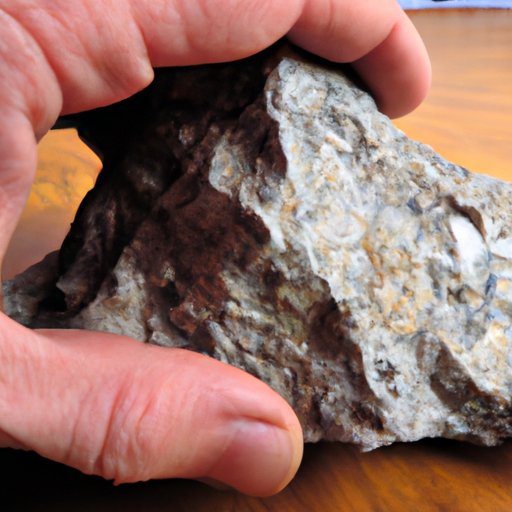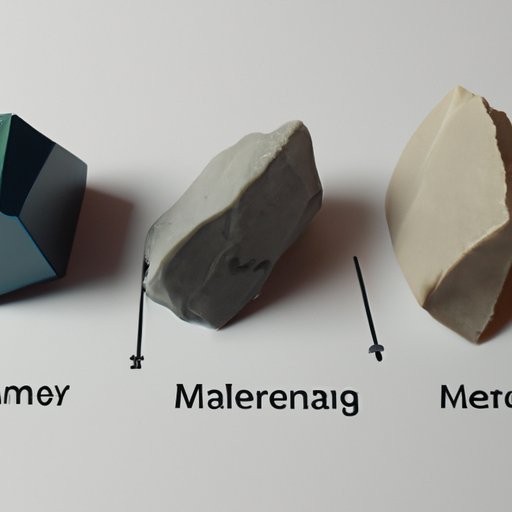Introduction
Minerals are naturally occurring substances found in the Earth’s crust. They come in many forms, including metals, gems, and rocks. Knowing which minerals are the strongest can help us understand the makeup of our planet and its resources. But what is the strongest mineral?
When it comes to determining the strength of a mineral, there is no single answer. Different factors can influence a mineral’s strength, such as its composition, structure, and physical properties. In this article, we will explore the various tests used to measure a mineral’s strength, examine some of the strongest minerals on Earth, and rank the world’s hardest minerals.
Examining the Hardness of Minerals: What is the Strongest Mineral?
The hardness of a mineral is one of the major factors that determines its strength. Hardness is a measure of how resistant a mineral is to being scratched, abraded, or broken. The Mohs scale of mineral hardness is a commonly used system for measuring the hardness of minerals. This system was developed by German mineralogist Friedrich Mohs in 1812 and assigns a number from 1 to 10 to each mineral, with 1 being the softest and 10 being the hardest.
Other tests used to measure mineral hardness include the Brinell test, which measures the hardness of a mineral by pressing a steel ball into its surface; the Vickers test, which uses a diamond pyramid indenter to measure the hardness of a mineral; and the Rockwell test, which measures the indentation made by a diamond cone on a mineral’s surface.
There are many minerals that have been classified as very hard. Some examples of the strongest minerals include diamond (10 on the Mohs scale), corundum (9 on the Mohs scale), and quartz (7 on the Mohs scale).
Exploring Earth’s Treasures: The Most Durable Mineral on Earth
The most durable mineral on Earth is diamond. Diamonds are composed of pure carbon atoms arranged in an extremely strong lattice structure. They are the hardest natural substance known to man and are highly resistant to scratching, abrasion, and corrosion. The diamond’s hardness makes it ideal for use in industrial applications, such as cutting tools and abrasives.
Diamonds are not the only minerals that are highly durable. Other minerals, such as corundum and quartz, are also very hard and resistant to damage. Corundum is a crystalline form of aluminium oxide and is second only to diamond in terms of hardness. Quartz is a silicate mineral that is also very hard and durable.

Investigating Mineral Strength: Discovering the Toughest Mineral Known to Man
The toughest mineral known to man is wurtzite boron nitride. This mineral is composed of nitrogen and boron atoms arranged in a hexagonal lattice. It is extremely hard, resistant to damage, and has a high melting point. Wurtzite boron nitride is often used in industrial applications, such as cutting tools and abrasives.
To determine the strength of wurtzite boron nitride, scientists use a variety of tests and measurements. These tests include the Mohs scale, the Brinell test, the Vickers test, and the Rockwell test. By comparing the results of these tests, scientists can determine the strength of this mineral compared to other minerals.
In terms of hardness, wurtzite boron nitride is significantly harder than diamonds, corundum, and quartz. It is also more resistant to damage and has a higher melting point. Therefore, it is considered to be the toughest mineral known to man.
Geological Wonders: Ranking the World’s Hardest Minerals
The world’s hardest minerals can be ranked according to their hardness on the Mohs scale. The ranking system starts with talc at 1, followed by gypsum, calcite, and fluorite at 2, 3, and 4 respectively. Moving up the scale, apatite, orthoclase, and quartz are ranked 5, 6, and 7 respectively. At 8, 9, and 10, the rankings are topaz, corundum, and diamond respectively.
Talc is the softest mineral on the Mohs scale and is easily scratched with a fingernail. Gypsum and calcite are slightly harder and require a steel nail to scratch them. Fluorite is even harder and requires a knife to scratch it. Apatite and orthoclase are harder still and require a file to scratch them. Quartz is harder yet and requires a chisel to scratch it. Topaz is much harder and requires a hammer to scratch it. Corundum is even harder and requires a diamond to scratch it. Finally, diamond is the hardest mineral and requires another diamond to scratch it.
Each of these minerals has unique characteristics that make them useful in different ways. Talc, for example, is often used in cosmetics and soap because of its softness and powdery texture. Gypsum and calcite are used in construction materials, such as drywall and concrete. Fluorite is used in jewelry and optical equipment. Apatite is used in fertilizer and animal feed. Orthoclase is used in porcelain and ceramics. Quartz is used in glass and electronics. Topaz is used in jewelry and gemstones. Corundum is used in abrasives and grinding wheels. Finally, diamond is used in jewelry, cutting tools, and abrasives.
From Diamonds to Granites: Analyzing the Hardest Mineral on Earth
The hardest mineral on Earth is diamond. Diamonds are composed of pure carbon atoms arranged in an extremely strong lattice structure. They are the hardest natural substance known to man and are highly resistant to scratching, abrasion, and corrosion. The diamond’s hardness makes it ideal for use in industrial applications, such as cutting tools and abrasives.
In comparison to other minerals, diamonds are significantly harder than quartz, corundum, and wurtzite boron nitride. They are also more resistant to damage and have a higher melting point. Therefore, diamonds are considered to be the strongest mineral on Earth.
Conclusion
In conclusion, the strength of a mineral is determined by its composition, structure, and physical properties. Different tests can be used to measure a mineral’s hardness, such as the Mohs scale, the Brinell test, the Vickers test, and the Rockwell test. Examples of the strongest minerals include diamond, corundum, and quartz. The toughest mineral known to man is wurtzite boron nitride, and the hardest mineral on Earth is diamond. By understanding the strength of different minerals, we can better understand the makeup of our planet and its resources.
(Note: Is this article not meeting your expectations? Do you have knowledge or insights to share? Unlock new opportunities and expand your reach by joining our authors team. Click Registration to join us and share your expertise with our readers.)
